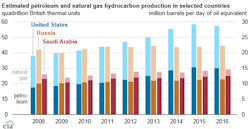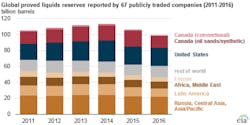US produces most petroleum, natural gas hydrocarbon
Graphic courtesy of the EIA
For the fifth straight year, the U.S. remained the world’s top producer of petroleum and natural gas hydrocarbons despite production declines for both petroleum and natural gas levels in the previous year, according to the U.S. Energy Information Administration (EIA). The U.S. has been the world’s top producer of natural gas since 2009, and has been the world’s top producer of petroleum hydrocarbons since 2013.
Price spread widens between premium, regular gasoline
Growing octane needs in the U.S. are widening the spread between premium and regular gasoline, according to the EIA. The difference between the average retail price for the two gas grades reached 50 percent in late 2016. The growth has been the trend since 2000, but has accelerated in the past three years. This growth is credited to many factors.
Global oil markets expected to tighten in late 2017
The Organization of the Petroleum Exporting Countries (OPEC) announced the crude oil production target will remain at 32.5 million barrels per day (b/d) through the end of the first quarter of 2018. As a result, the EIA predicts in its May Short-term Energy Outlook that OPEC crude oil production will average 32.3 million b/d in 2017 and 32.8 million in 2018, about 0.2 million b/d and 0.4 million b/d, respectively, lower than previously forecasted.
Graphic courtesy of the EIA
Oil companies’ liquid reserves decline in 2016
Aggregate liquid reserves of publicly traded oil companies dropped in 2016 for the second consecutive year, according to the EIA. Because the 67 companies are listed on the U.S. stock exchanges, they are required to report their proved reserves annually to the U.S. Securities Exchange Commission. Altogether, the companies’ global crude oil and other liquids production averaged 24 million barrels per day during 2016, about a quarter of the global total.
Mexico conducts its first natural gas pipeline capacity open season
The National Center for Natural Gas Control (Centro National de Control del Gas Natural – CENAGAS) in Mexico conducted its first open season for capacity rights on the national natural gas grid as part of ongoing energy reforms, according to the EIA. CENAGAS was created in 2014 as a decentralized public entity entrusted with assigning capacity rights for pipelines previously owned, operated and largely used by Petroleus Mexico, or PEMEX. Historically the legal monopoly owner of the country’s pipeline assets, PEMEX is now being dismantled as part of Mexico’s energy reform and transitioned into a more open market where foreign and local companies can compete to offer the best prices and services to customers.
Jet fuel use remains well below its previous peak
U.S. airlines carried 7 percent more passengers in 2016 than in 2007, but jet fuel use in the U.S. in 2016 remained 11 percent lower than its level a decade earlier. This is despite consumption by U.S. airlines increasing in 2015 and 2016, according to the EIA.




